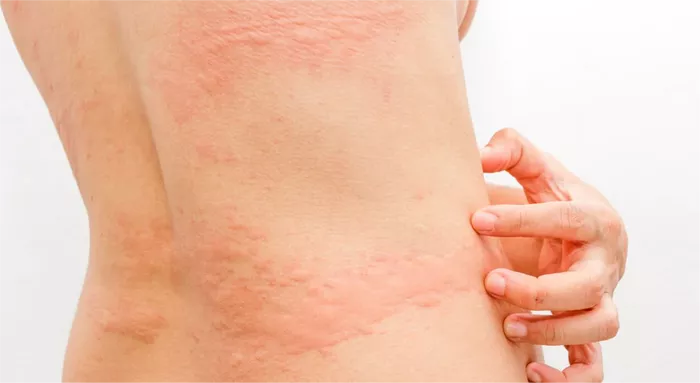Hives, medically known as urticaria, are a common skin reaction characterized by raised, itchy welts that can appear anywhere on the body. These welts can vary in size and shape and often appear suddenly due to the release of histamine and other chemicals into the bloodstream. The causes of hives can range from allergic reactions to stress, infections, and even certain medications or food additives. Understanding the triggers for hives is crucial in managing and preventing outbreaks.
The severity and duration of hives can vary greatly among individuals. While some may experience mild, short-lived episodes, others may endure more severe and prolonged outbreaks. The duration of hives can range from a few hours to several weeks, depending on the underlying cause and individual factors.
Antihistamine Function:
Antihistamines are the primary treatment for relieving the symptoms of hives. These medications work by blocking the action of histamine, a chemical released by the body during an allergic reaction. Histamine is responsible for causing the characteristic itching, swelling, and redness associated with hives. By blocking histamine receptors, antihistamines effectively alleviate these symptoms, providing relief to those suffering from hives.
There are two generations of antihistamines available, each with its own set of characteristics. First-generation antihistamines, such as diphenhydramine (Benadryl), tend to cause more drowsiness due to their ability to cross the blood-brain barrier. While effective at relieving symptoms, they may not be suitable for daytime use or for individuals who need to remain alert.
On the other hand, second-generation antihistamines, including loratadine (Claritin), cetirizine (Zyrtec), and fexofenadine (Allegra), are preferred for their non-drowsy properties. These medications have a lower affinity for crossing the blood-brain barrier, resulting in fewer sedative effects. This makes them ideal for daytime use, allowing individuals to manage their hives symptoms without experiencing drowsiness or impaired cognitive function.
Recommended Antihistamines for Hives:
1. Loratadine (Claritin): Loratadine is a second-generation antihistamine available over-the-counter in various forms, including tablets and liquids. It is known for its efficacy in relieving itching and reducing the size and number of hives. The recommended dosage for adults is typically 10 mg once daily.
2. Cetirizine (Zyrtec): Cetirizine is another second-generation antihistamine that provides long-lasting relief from hives symptoms. It is available in various formulations, including tablets, liquids, and dissolvable tablets. The recommended dosage for adults is 10 mg once daily.
3. Fexofenadine (Allegra): Fexofenadine is a non-drowsy antihistamine that is highly effective in treating hives. It is available in tablet and liquid form and is typically taken at a dosage of 180 mg once daily for adults.
While these second-generation antihistamines are generally well-tolerated, they may still cause mild side effects such as headache, dry mouth, or nausea in some individuals. It is essential to consult with a healthcare professional before starting any new medication, especially if you have underlying medical conditions or are taking other medications.
For those who require immediate relief from severe hives symptoms, first-generation antihistamines like diphenhydramine (Benadryl) may be effective. However, it is important to note that diphenhydramine can cause significant drowsiness, making it less suitable for daytime use.
Additional Tips for Managing Hives:
In addition to antihistamine therapy, there are several other strategies for managing and preventing hives outbreaks:
1. Topical Treatments: Calamine lotion or menthol-based creams can help soothe itching and provide temporary relief. Cool compresses can also help reduce inflammation and discomfort.
2. Lifestyle Changes: Identifying and avoiding triggers is key to preventing hives outbreaks. Common triggers include certain foods, medications, insect bites, and environmental factors such as heat or cold. Stress management techniques such as yoga, meditation, or deep breathing exercises may also help reduce the frequency and severity of hives.
3. When to See a Doctor: While most cases of hives can be managed at home with over-the-counter medications and lifestyle changes, it is important to seek medical attention if you experience severe symptoms, such as difficulty breathing, swelling of the lips or throat (angioedema), or if the hives are persistent and recurring. Chronic hives may require further evaluation and treatment by a healthcare professional to identify underlying causes and develop a comprehensive management plan.
Conclusion
In conclusion, finding the best antihistamine for hives depends on individual preferences and the severity of symptoms. Second-generation antihistamines like loratadine, cetirizine, and fexofenadine offer effective relief with minimal drowsiness, making them suitable options for most individuals. However, it is essential to consult with a healthcare professional to determine the most appropriate treatment plan based on your specific needs and medical history. Additionally, incorporating lifestyle changes and topical treatments can further enhance the management of hives and improve overall quality of life.
























